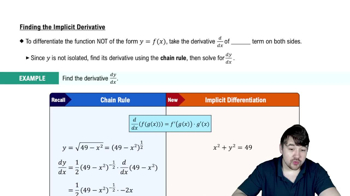Table of contents
- 0. Functions7h 52m
- Introduction to Functions16m
- Piecewise Functions10m
- Properties of Functions9m
- Common Functions1h 8m
- Transformations5m
- Combining Functions27m
- Exponent rules32m
- Exponential Functions28m
- Logarithmic Functions24m
- Properties of Logarithms34m
- Exponential & Logarithmic Equations35m
- Introduction to Trigonometric Functions38m
- Graphs of Trigonometric Functions44m
- Trigonometric Identities47m
- Inverse Trigonometric Functions48m
- 1. Limits and Continuity2h 2m
- 2. Intro to Derivatives1h 33m
- 3. Techniques of Differentiation3h 18m
- 4. Applications of Derivatives2h 38m
- 5. Graphical Applications of Derivatives6h 2m
- 6. Derivatives of Inverse, Exponential, & Logarithmic Functions2h 37m
- 7. Antiderivatives & Indefinite Integrals1h 26m
- 8. Definite Integrals3h 25m
4. Applications of Derivatives
Implicit Differentiation
Problem 3.8.91
Textbook Question
90–93. {Use of Tech} Work carefully Proceed with caution when using implicit differentiation to find points at which a curve has a specified slope. For the following curves, find the points on the curve (if they exist) at which the tangent line is horizontal or vertical. Once you have found possible points, make sure that they actually lie on the curve. Confirm your results with a graph.
x²(3y²−2y³) = 4
 Verified step by step guidance
Verified step by step guidance1
Start by applying implicit differentiation to the equation x²(3y²−2y³) = 4 with respect to x. Remember to use the product rule for the term x²(3y²−2y³).
Differentiate both sides of the equation. The left side will involve differentiating x² and the expression (3y²−2y³) while treating y as a function of x, which requires using the chain rule.
Set the derivative equal to zero to find points where the tangent line is horizontal. This will help you identify the y-values where dy/dx = 0.
To find points where the tangent line is vertical, set the denominator of dy/dx equal to zero. This will give you the x-values where the slope is undefined.
Substitute the x and y values obtained from the previous steps back into the original equation to confirm that these points lie on the curve.
Recommended similar problem, with video answer:
 Verified Solution
Verified SolutionThis video solution was recommended by our tutors as helpful for the problem above
Video duration:
9mPlay a video:
Was this helpful?

 5:14m
5:14mWatch next
Master Finding The Implicit Derivative with a bite sized video explanation from Nick
Start learningRelated Videos
Related Practice



